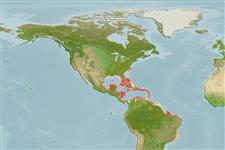Common names from other countries
>
Eupercaria/misc (Various families in series Eupercaria) >
Labridae (Wrasses) > Corinae
Etymology: Halichoeres: Greek, als, alis = salt + Greek, choiros = pig (Ref. 45335).
More on author: Bloch.
Environment: milieu / climate zone / depth range / distribution range
Sinh thái học
Biển Cùng sống ở rạn san hô; Mức độ sâu 1 - 15 m (Ref. 9710). Tropical; 37°N - 26°S, 100°W - 28°W
Western Atlantic: North Carolina, USA and Bermuda to Brazil (Ref. 7251).
Bộ gần gũi / Khối lượng (Trọng lượng) / Age
Maturity: Lm ? range ? - ? cm
Max length : 35.0 cm TL con đực/không giới tính; (Ref. 55367); Khối lượng cực đại được công bố: 146.00 g (Ref. 9626)
Các tia vây lưng cứng (tổng cộng) : 9; Tia cứng vây hậu môn: 3; Tia mềm vây hậu môn: 12. The dominant color markings are two dark stripes, one running from snout through eye to caudal base and the other, less pronounced, on lower side of body; a bicolored spot at edge of gill cover within upper dark stripe; large adult males green on back, shading to light greenish yellow on sides, the two stripes usually purplish; irregular light red bands on head and on caudal fin (Ref. 13442).
Commonly found in rocky and reef areas in shallow waters. Less common in seagrass beds. Feeds on other fishes (Ref. 5521) and gastropods (Ref. 9626). Forms leks during breeding (Ref. 55367). A protogynous hermaphrodite (Ref. 55367).
Life cycle and mating behavior
Maturities | Sự tái sinh sản | Spawnings | Egg(s) | Fecundities | Ấu trùng
Diandric. Pelagic spawner (Ref. 32222). Sex reversal is completed in more than 3-4 weeks (Ref. 34185, 34257). Length at sex change = 30.2 cm TL (Ref. 55367).
Robins, C.R. and G.C. Ray, 1986. A field guide to Atlantic coast fishes of North America. Houghton Mifflin Company, Boston, U.S.A. 354 p. (Ref. 7251)
IUCN Red List Status (Ref. 130435)
CITES (Ref. 128078)
Not Evaluated
Threat to humans
Harmless
Human uses
Các nghề cá: Tính thương mại; Bể nuôi cá: Tính thương mại
Các công cụ
Special reports
Download XML
Các nguồn internet
Estimates based on models
Preferred temperature (Ref.
115969): 24.4 - 28.2, mean 27.3 (based on 713 cells).
Phylogenetic diversity index (Ref.
82804): PD
50 = 0.5000 [Uniqueness, from 0.5 = low to 2.0 = high].
Bayesian length-weight: a=0.00912 (0.00581 - 0.01432), b=3.07 (2.94 - 3.20), in cm Total Length, based on LWR estimates for this species & Genus-body shape (Ref.
93245).
Mức dinh dưỡng (Ref.
69278): 3.8 ±0.1 se; based on diet studies.
Thích nghi nhanh (Ref.
120179): Trung bình, thời gian nhân đôi của chủng quần tối thiểu là 1.4 - 4.4 năm (Preliminary K or Fecundity.).
Fishing Vulnerability (Ref.
59153): Low vulnerability (25 of 100).
